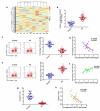Silencing of long non-coding RNA NEAT1 improves Treg/Th17 imbalance in preeclampsia via the miR-485-5p/AIM2 axis
- PMID: 34696702
- PMCID: PMC8806521
- DOI: 10.1080/21655979.2021.1982306
Silencing of long non-coding RNA NEAT1 improves Treg/Th17 imbalance in preeclampsia via the miR-485-5p/AIM2 axis
Abstract
T-regulatory (Treg)/T-helper 17 (Th17) imbalance is associated with preeclampsia (PE). Herein, we aimed to explore the effect and mechanism of lncRNA NEAT1 on the Treg/Th17 balance. The levels of nuclear enriched abundant transcript 1 (NEAT1), miR-485-5p, and absent in melanoma 2 (AIM2) in CD4+ T cells were determined using real-time quantitative polymerase chain reaction (RT-qPCR). Treg and Th17 cells were examined using flow cytometry. The relationship between miR-485-5p and NEAT1 or AIM2 was assessed using a dual-luciferase reporter assay. Pearson's correlation coefficient was used to analyze the correlation. All the data indicated that NEAT1 was upregulated in PE. The number of Treg cells decreased and was negatively related to NEAT1, whereas the number of Th17 cells increased and was positively related to NEAT1 in PE. Knockdown of NEAT1 increased the Treg cells and Treg/Th17 but decreased Th17 cells. Furthermore, NEAT1 sponges miR-485-5p to suppress the target AIM2 levels. Inhibition of miR-485-5p or upregulation of AIM2 abrogated the effect on Treg/Th17 balance induced by knockdown of NEAT1. In conclusion, silencing of NEAT1 promoted Treg/Th17 balance via the miR-485-5p/AIM2 axis in PE, suggesting that NEAT1 is a potential target for the treatment of PE.
Keywords: Preeclampsia; lncRNA; miR-485-5p/aim2 axis; neat1; treg/th17.
Conflict of interest statement
The authors declared that they have no competing interest.
Figures






References
-
- Bokslag A, van Weissenbruch M, Mol BW, et al. Preeclampsia; short and long-term consequences for mother and neonate. Early Hum Dev. 2016;102:47–50. - PubMed
-
- El-Sayed AAF. Preeclampsia: a review of the pathogenesis and possible management strategies based on its pathophysiological derangements. Taiwan J Obstet Gynecol. 2017;56(5):593–598. - PubMed
-
- Mol BWJ, Roberts CT, Thangaratinam S, et al. Pre-eclampsia. Lancet. 2016;387(10022):999–1011. - PubMed
-
- Jido TA, Yakasai IA.. Preeclampsia: a review of the evidence. Ann Afr Med. 2013;12(2):75–85. - PubMed
Publication types
MeSH terms
Substances
LinkOut - more resources
Full Text Sources
Research Materials
